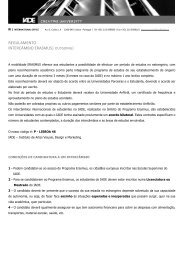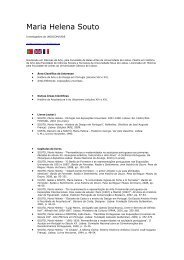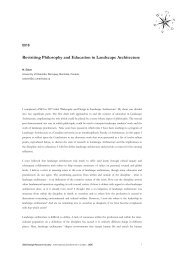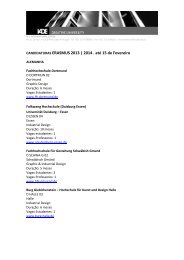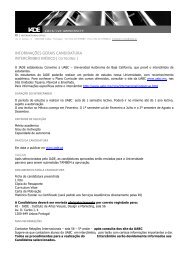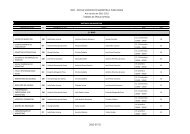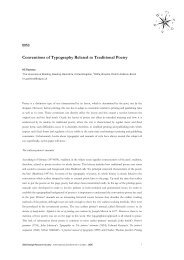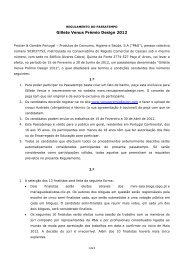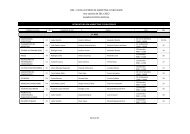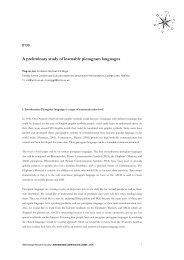THE INTEGRATION OF GRAPHIC DESIGN AND BRANDING: THE ...
THE INTEGRATION OF GRAPHIC DESIGN AND BRANDING: THE ...
THE INTEGRATION OF GRAPHIC DESIGN AND BRANDING: THE ...
You also want an ePaper? Increase the reach of your titles
YUMPU automatically turns print PDFs into web optimized ePapers that Google loves.
2009<br />
International Conference<br />
DAY 2 :: 2nd October 2009 :: 11th Session :: Abstracts<br />
1/2<br />
The Integration Of Graphic Design And Branding:<br />
The Corporate Visual Identity As A Differentiation Tool<br />
Graphic Design, Visual Corporate Identity, Branding<br />
Marco Aurélio Petrelli<br />
Universidade Federal de Santa Catarina<br />
LOGO<br />
Luiz Salomão Ribas Gomez<br />
Universidade Federal de Santa Catarina<br />
LOGO, UNIDCOM/IADE<br />
This study aims to understand the integration reusing graphic design in the management of<br />
its corporate identities, based on the visualization of actions related to the management of the<br />
brand, the corporate branding and finally, by brand elements. The methodology used for its<br />
development is descriptive, determining the process and logical interpretation, addressing 3<br />
specific points: Branding, the Corporate Visual Identity and Brand Elements. The results presents<br />
a picture that provides improvements, once found the understanding of the relevance of this<br />
issue by the industry participants.<br />
Jan Raphael Reuter Braun<br />
Faculdade SATC<br />
The Portuguese Rissole: A Recipe for Inclusion<br />
Inclusive Design, People With Special Needs, Eating, Popular Gastronomy, Rissole<br />
Paula Trigueiros<br />
Escola Universitária das Artes<br />
de Coimbra (EUAC)<br />
UNIDCOM/IADE<br />
paula.trigueiros@gmail.com<br />
Alison Burrows<br />
University of Loughborough<br />
alison.burrows@gmail.com<br />
Rua G Lote 86/87, São Silvestre,<br />
People the world over see food as more than a need, it is a pleasure to be enjoyed. Furthermore,<br />
good nutrition is essential to everyone and remains important throughout life. As people age<br />
they suffer physical, mental and health related decline, which means their abilities change. Even<br />
though people are living longer and healthier lives, many of them will eventually be affected<br />
by one or more physical and/or mental impairments. Researchers have been concerned with<br />
the needs of an ageing population and how products and services can respond to those needs,<br />
but they have paid little attention to food as one such product (except from the nutritional aspect).<br />
Designers, on the other hand, have seen the potential for design in food, though without<br />
exploring the need for its inclusiveness. This paper looks at factors associated with ageing and<br />
describes how the characteristics of the Portuguese rissole (known as “rissól”) make it a food<br />
item that can be easily consumed by people with sight impairments, poor dexterity and special<br />
dietary requirements such as older adults. The idea that traditional and popular gastronomy<br />
may provide simple and affordable solutions to complex problems is discussed, paving the way<br />
for interdisciplinary collaborations between people involved in the field of Inclusive Design and<br />
professionals from the food and catering sectors.<br />
:: IADE Creative University :: IADE Chiado Center :: Rua do Alecrim, nº 70 :: 1200-018 :: Lisbon, Portugal :: Tel: (+351) 21 393 9600 www.iade.pt/40iade40/
2009<br />
International Conference<br />
DAY 2 :: 2nd October 2009 :: 11th Session :: Abstracts<br />
2/2<br />
Avieira culture<br />
Cultura Avieira, Barco, Arquitectura, Sustentabilidade, Património Nacional<br />
Carlos Barbosa<br />
IADE, UNIDCOM, NDS,<br />
Lisbon - Portugal<br />
João Palla Martins<br />
UNIDCOM/IADE<br />
The condition and geographical universe of these fishermen populations are unique in Europe<br />
and unrecognized since is unknown to major public. Although this culture’s still alive with its<br />
own traditions and beliefs there is an imminent risk of losing identity due to various factors. The<br />
aim of this presentation is to focus the importance of this specific culture as a potential work in<br />
different disciplines.<br />
The present communication is part of an overall project to promote Avieira Culture as a<br />
national heritage. Understanding this very specific culture will lead us to the mid-19th century,<br />
when seasonal migratory movements occurred from the land of Gândara, on the coast Centre<br />
towards the south. The extensive growing areas of the Tagus River attracted and absorbed the<br />
work force coming from other parts of the country - with more seasonal characteristics which<br />
initially developed as a primary fishing activity, being born of a genuine cultural identity in this<br />
community generated. The imprint of this culture identity is registered, not only in its intangible<br />
but also in its material heritage.<br />
The scope of our work is focused on the material legacy, recognizing the evidence of its<br />
intrinsic value, but also revealing the particular characteristics of a sustainable development<br />
process, which may consider preserving the environment, ecological systems and biodiversity,<br />
opportunity to disseminate and implement socio cultural aspects and the creation of economic<br />
factors that contribute to the well being of communities. We’ll address the<br />
:: IADE Creative University :: IADE Chiado Center :: Rua do Alecrim, nº 70 :: 1200-018 :: Lisbon, Portugal :: Tel: (+351) 21 393 9600 www.iade.pt/40iade40/




